Welcome to the week. Before we get to work, let’s make sure we are informed of the most notable news from the past seven days.
Here’s what you need to know today…
Traffic enforcement reform now!: A new investigation from NPR found that over 25% of fatal police shootings of unarmed Black people occurred during traffic stops.
Bike touring in the time of Covid: The BBC covered a UK man’s attempt at a global bike tour during a global pandemic.
CW: Police officer runs over people: A horrible scene unfolded in Tacoma (WA) Saturday night as a police officer in an SUV intentionally ran over a large group of people who had stopped traffic in an intersection to do burnouts and hang out.
Bikability metric: We love how this story about planning for bicycling around transit stations in Seattle includes a “Level of traffic stress” metric.
“Doughnut city”: Forget the “15-minute neighborhood” or “20-minute city”, Amsterdam is doing something much more bold that transcends bicycling and urban planning and gets to the heart of economic justice by questioning capitalism.
Advertisement
SUVs ruin everything: The welcome reduction in emissions from car users due to the pandemic was completely wiped out because of increased sales of big, gas-guzzling, emissions-spewing, people-killing, community-destroying SUVs.
Latest from Paris: Seems like each week we have amazing news to share from Paris. The latest? more active transportation representation at the US DOT.
Federal bearings: Curious about the potential and inner-workings of the US DOT now that we have the most promising Transportation Secretary in a generation and a Democrat in the White House? Check this podcast featuring the wonderful Beth Osborne from Transportation for America.
Advertisement
Money money money: Advocates in Washington are eager to push for a $26 billion statewide transportation funding package introduced by Democrats that would invest “over $80 million for every 2-year state budget in active transportation grants alone.”
B2V: In a bid to make roads safer for cycling, industry bigwigs Trek, Specialized, Shimano and SRAM are part of a partnership (that includes Ford) to create a new “Bicycle to Vehicle” (B2V) communication technology standard.
E-bike exemption: A bill in the Washington legislature proposed by a Democrat from Bellingham would exempt electric bikes and up to $200 in bike accessories from the state sales tax.
Got bikes? A coalition of bike companies in the UK have joined together to form a “marketing board” (similar to the “Got milk?” campaign) that will focus on catchy campaigns to boost bicycling awareness and ridership.
— Jonathan Maus: (503) 706-8804, @jonathan_maus on Twitter and jonathan@bikeportland.org
— Get our headlines delivered to your inbox.
— Support this independent community media outlet with a one-time contribution or monthly subscription.


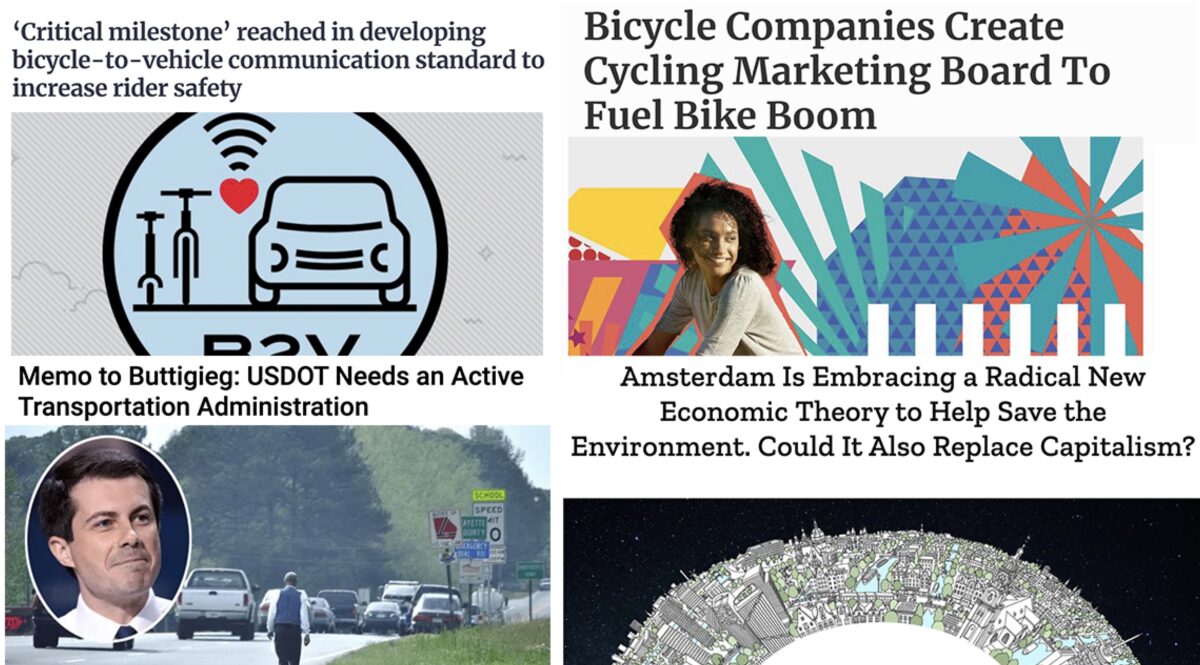
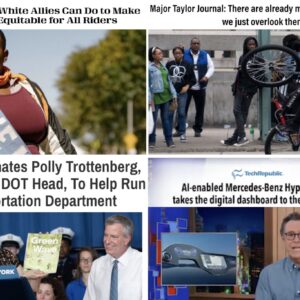
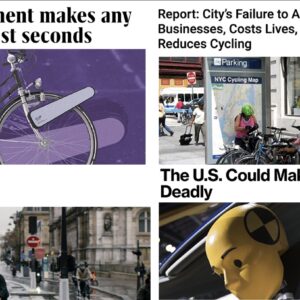
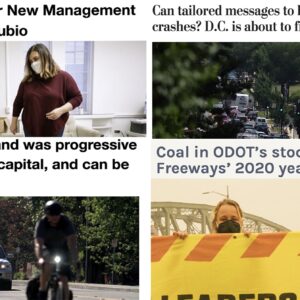
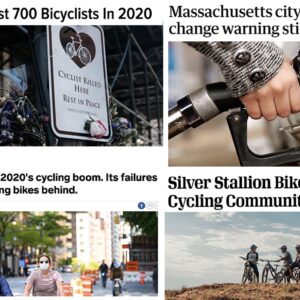
Thanks for reading.
BikePortland has served this community with independent community journalism since 2005. We rely on subscriptions from readers like you to survive. Your financial support is vital in keeping this valuable resource alive and well.
Please subscribe today to strengthen and expand our work.
To put that 25% number into context, it would be helpful to know what proportion of police contacts with unarmed black people are traffic stops. Are traffic stops disproportionately deadly compared to other interactions? If so, why? What can we do to make those contacts safer?
From the doughnut city article (which I thought was Basingstoke, UK, on account of all the damned roundabouts):
What? We are? Where/how/etc?
Yeah I think the writer got that mixed up. There was a quote from a Portlander (former City Hall staffer who now works for a climate policy group), but I haven’t heard anything like this being seriously considered by planning or economic folks around here.
Two words for you: Voo Doo.
You glazed over the plan.
Regarding B2V. Great, not getting run over by a “smart” car is now YOUR responsibility. You thought helmet scolds were annoying? Wait til this comes online.
If you want cycling to get more safe it is going to take a lot of small steps just like this. The reason that commercial air travel is so safe now is that they made many small changes based on accident data. One system that aircraft now use is much like this B2V. It is call TCAS https://en.wikipedia.org/wiki/Traffic_collision_avoidance_system This system was a response to aircraft flying into each other.
The government has and should require changes to vehicles and users of the road to make things safer because individuals are not good judges of risk and are irresponsible. We would not need speed limits or red light cameras if we could count on individuals to make good decisions regarding the safety of all road users. Helmets, B2V, Forward collision warning systems, backup cameras, air bags, seat belts, brake lights, etc. are all improvements that improve the safety of drivers and riders.
So all pedestrians would have to have some sort of device on them at all times? What about children? Maybe we can just microchip babies at birth?
Because, like other kooky ideas like bike lights, this solution might not apply to 100% of cases, it’s really not worth investigating further. I will note, however, that we’ve found a way to entice children to light themselves up with those LED sneakers, so maybe that particular use case has a less drastic solution that what you proposed.
https://en.wikipedia.org/wiki/Appeal_to_ridicule
I mean, if you can make fun of an idea, maybe, possibly, it could be because it’s dumb. The application of technology (in this case proximity devices) without thinking about all the unintended and onerous consequences is a hallmark of our industrial and technological age. To suggest that we reorganize movement in public in such a way that all human locations are machine registered does result in some absurd and ridiculous scenarios.
Agreed. Is anyone suggesting we do that?
There is no need for the government to implant us with chips because we already have given Google, Apple, Amazon and others more information than any implanted chip could ever do with a smartphone, purchase history and internet search history. We can use the technology to help make people safer or not but big data already knows more about us than any government agency.
The problem is exactly that though. So every pedestrian with a smartphone is now “safe”, but children, or people who can’t afford, or choose not to be tracked by big tech are not. They will get blamed in the police reports for “not traveling with the NTSB Safety Chip technology”. This is exactly what we see with helmets today, and those aren’t even legally mandated in most states.
The reason why that won’t happen is that this scheme is too complex to work in practice: it relies on too many people having too much special powered equipment.
But hopefully by pursuing it, we’ll learn something that will be helpful with preventing crashes and injuries.
I think the concern is that the technology, in it’s real world implementation, and frankly advertising to consumers, will reduce attention given to the avoidance of collisions. You can already see this in car commercials showing inattentive and poor driving habits but in a conciliatory or knowing acknowledgement of their social acceptability.
To keep with the aviation safety theme. This is much more like MCAS. In a quest for operational efficiencies (fewer training hours and investment in crews’ safety system knowledge) a software solution was implemented to patch a training and ultimately an aeronautical design problem. This produced a technological system that removed the skilled operator’s agency/responsibility from the actual control of the plane. And that was disastrous. The aviation safety industry is having a bit of a reckoning right now, so maybe not the best sector to turn to for safety software solutions.
The last fatal commercial airline fatality in the US was in 2009. In the last 10 years it has literally been infinitely safer than any other type of transport when it comes to deaths per mile or deaths per hour. https://www.cnbc.com/2019/02/13/colgan-air-crash-10-years-ago-reshaped-us-aviation-safety.html
I don’t see many skilled operators driving cars these days. I see a bunch of people talking on cell phones, eating food, playing with the radio, speeding, and running stop lights and signs. The sooner we take the control of automobiles away from drivers the safer we will be.
Ah, ok. So I think that’s where we differ. I haven’t given up on holding drivers responsible for their actions. You correctly identified the key difference between the aviation industry’s safety culture and American auto culture. One is full of professionals that hold themselves to a high standard and the other is given a pass at every possible point. In fact pilots are rightly angry that Boeing felt they could implement a software that overrode and contradicted their judgment and training.
We need drivers to be more skilled and responsible. And they should pay in both time and money for the privilege to train to use an undeniably dangerous form of transportation in a safe manner. I don’t want to walk or ride around with a phone transmitting my proximity to every car for fear that the unskilled and inattentive driver will run me down. I realize phones and their tracking capabilities are ubiquitous, my concern isn’t a data privacy one. More one of proportionality and of victim blaming. It perpetuates the largely untrue assertion that bike and pedestrian collisions are effectively unavoidable for drivers. “They came out of nowhere”, if only they were responsible and had their phone app turned on. Drivers need to wake up and shoulder some responsibility.
Based on the recent car attack in SE Portland I’m willing to double down on my opinion that we should keep drivers from being able to control their cars ASAP to make people safer. The sooner there is not a steering wheel, brake, or accelerator controlled by a driver the better off we will be. Bring on the computer governed automobile.
The two fatal 737-Max crashes didn’t take place in the US, but they easily could have… And Boeing, who created those death-planes (need I remind you?) is based in Washington.
Actually they are headquartered in Chicago. Since 2001
Sadly Indonesia has a terrible flight safety record and the reason that 737 crashed was a faulty refurbished AOA sensor along with the Boeing software. The reason there were no US crashes was the airlines in the US airlines paid for the extra AOA sensor, better aircrew training, and a better safety culture. The Ethiopian crash was caused once again by a failed AOA sensor and pilot error by not following the checklist supplied (they skipped the 1st step) by Boeing after the first crash. While many developing countries have a worse safety record than the US even they are improving much faster than automobile, bike or pedestrian.
Good summary, Jon. Boeing was definitely complicit in these crashes, but it is extremely unlikely that a similar crash would have occurred at a western airline with the same equipment. Now, with the software and training changes, I wouldn’t hesitate to fly on a 737 MAX. I would be a bit hesitant to fly on any airline in Indonesia, though.
It is my understanding that these are not the accepted interpretations of the ultimate causes of the 737 MAX crashes. In particular the Ethiopian Air crash, what was checklist procedure that they disregarded? I thought they were basically screwed and did all they could given the info and training they had. I’m genuinely asking, because I hadn’t heard about the checklist oversight.
Maintenance in the case of the Lion Air crash was certainly a factor as the plane’s single malfunctioning Angle of Attack sensor (a Boeing supplied/approved product no less) was replaced with an incorrectly calibrated unit. But this was still an indication of a design, training, and software flaw. And it should have been handled differently by Boeing in terms of recommended training and notice bulletins to pilots, as well as ground crew, that were not supplied. Without knowledge of the system and a way to permanently disable it after a sensor malfunction, the pilots were placed in a very difficult situation.
Even the “upgraded” sensor package with two AOA sensors, as was seen in in the later Ethiopian crash, would not have helped since MCAS’s implementation at the time was to use only one sensor and not error check with the other.
The pilots in the Ethiopian Air crash where well aware of the MCAS issues and knew to switch off the electronic auto trim, and did so after correctly identifying the MCAS system was malfunctioning (it triggered twice just after takeoff adjusting the trim to an unsafe position given the airspeed and true AoA). But this excess airspeed (again caused by incorrect use by Boeing of a single sensor input for auto throttle) resulted in the manual trim adjustment screw to jam and become effectively unresponsive. Seemingly in desperation to return the trim to an acceptable setting they turned the electronic trim control back on and the 3rd MCAS intervention sent them into an unrecoverable dive. When other pilots recreated these conditions in simulators they too found the response of the plane difficult to understand and cope with even though they had the benefit of hindsight into the specific issue.
https://web.archive.org/web/20200310004955/http://www.aib.gov.et/wp-content/uploads/2020/documents/accident/ET-302%20%20Interim%20Investigation%20%20Report%20March%209%202020.pdf
Basically Boeing never asked the question: If this one AOA sensor fails, particularly on takeoff, will our new software designed to reduce pilot training requirements, and by definition we aren’t training pilots on, try to kill them in a confusing and relentless way?
This is why it’s a better, though still a bit tortured, aviation industry analogy to the push for bike-to-car sensor tech. Instead of focusing on driver training (or even more straightforward tech solutions like GPS based speed limiters), the auto industry is pulling the old “jaywalking menace” on the cycling world by implying that it’s cyclist who should through increasingly convoluted ways announce themselves to drivers in order to not be maimed or killed. If we aren’t training drivers to use cars safely now, are we going to include a checklist for when their Bike proximity sensor suite fails?
https://www.seattletimes.com/business/boeing-aerospace/what-led-to-boeings-737-max-crisis-a-qa/
Thanks! I didn’t realize the upgrade that US airlines presumably paid for was an indicator for AoA sensor mismatch. I thought it was the sensor itself being the extra. The Ethiopian report talks a lot about the mismatch of the two, so I assumed they had the upgrade.
I still think the pilot error take is more than a bit harsh. Obviously pilot actions are a component in almost every air crash. But as is covered in another ST article linked in the one you posted, the runaway stabilizer bulletin might have been insufficient, especially for younger pilots, not just less experienced ones on later model 737s.
https://www.seattletimes.com/business/boeing-aerospace/boeings-emergency-procedure-for-737-max-may-have-failed-on-ethiopian-flight/
The bulletin referring to a checklist for a similar but different issue, runaway stabilizer, didn’t convey the gravity of the, if you need to do stabilizer adjustments do them now or you won’t be able to later, nature of the first step of the checklist. They needed far more training and sim time, specifically with MCAS. But also with the roller coaster maneuver early 737 pilots learned for the 737-200 to temporarily relieve pressure on the screw mechanism to allow for manual adjustment. But like I said, the whole point of MCAS was to obviate extra training. So Boeing was not going to do that.
> So all pedestrians would have to have some sort of device on them at all times?
Chris, you thought it was crazy, but that’s actually what the auto industry seems to be hoping for. The B2V development paper refers to a “PSM” (personal safety message”) from “VRUs” (vulnerable users like pedestrians and road workers).
The concept is not new either. This is from 2017:
> This document provides recommendations of safety message minimum performance requirements between a Vulnerable Road User (VRU) and a vehicle. It addresses the transmission of Personal Safety Messages (PSM) from road user devices carried by pedestrians, bicycle riders and public safety personnel, to provide driver and vehicle system awareness and potentially offer safety alerts to VRUs. https://www.sae.org/standards/content/j2945/9_201703/
The “some sort of device” these folks figure all pedestrians have is a smartphone.
The problems I see are: 1) smartphone battery life (vs lots of GPS/sensor/wireless usage required for this scheme), 2) the assumption that what pedestrians really need are warnings in their pocket about a 2-ton vehicle whizzing at them, and 3) the notion that the best way to improve pedestrian safety is to design for a best case scenario where drivers and pedestrians (or cyclists) all have powered & functioning electronic devices speaking the same language; in reality we know not all pedestrians will – especially the most vulnerable like very young, old, or economically disadvantaged or just any human who forgets their pocket spyfone or would rather not carry one for whatever reason that day.
I think Specialized, Trek, et al should keep working on this, but I hope they’re also lobbying for automotive safety standards like Europe has[1], which requires vehicle design that protects pedestrians when crashes do happen. B2V and “VRU messages from smartphones” might help a lot five years from now, but over five years *ago* European car companies were already building safer cars, like those with external airbags made for pedestrians[2,3].
1: https://usa.streetsblog.org/2017/12/07/while-other-countries-mandate-safer-car-designs-for-pedestrians-america-does-nothing/
2: https://www.youtube.com/watch?v=CiiBlirAG8w
3: https://www.popsci.com/cars/article/2013-02/volvos-new-airbags-protect-pedestrians-too/
Couldn’t the technology be used in reverse to cause great harm too? For example, Jack T. Ripper gets into his Escalade and wants to maim as many redheads as possible, so he uses the handy BV2 app in his truck and selects victims based on the computer database. The system then tells him the best route based on either shortest distance or shortest time, with optimal efficiencies on hits.
BV2 calculating…
Latest from Paris: Page Not Found. Broken link?
I think JM mixed 2 links together. He could really use an intern. Here is the story: https://www.cyclingweekly.com/news/racing/tour-de-france/champs-elysees-to-be-turned-into-extraordinary-garden-in-e200m-makeover-488164
Thanks for trying, but nothing in that article about US DOT personnel…
I agree that I would hate for it to be another reason to shift blame. As for the technology, I would hope it would be something more like an app you could download on a phone that would use bluetooth, ANT etc to communicate with cars, rather than something that needs to be installed on bikes. The advantage also being that any other ped, scooter, person could use the same low-cost technology.
> I would hope it would be something more like an app you could download on a phone that would use bluetooth, ANT etc to communicate with cars
It is using Bluetooth:
From the paper:
“The transmission path is one-way from the VRU [vulnerable road user] to the vehicle. This scheme has the benefit of using simpler, lower-cost hardware for the VRU. Another advantage is longer battery life for the VRU-mounted device, which can be mounted in a helmet, on a smartphone, or within a bike headlight.”
It is darkly comical that the ‘merkin media piece failed to mention that the entire impetus for the “doughnut model” was the observation that ~60% of Amsterdam’s emissions come from consumption of things produced elsewhere*. Portland’s C40 analyses also found that the bulk of Portland’s emissions come from imported consumption (~70%) and that these emissions complete obliterate small decreases in production-based emissions. (Ironically, the C40 consumption metric was greenwashed out of PDX’s most recent report.)
https://www.theguardian.com/world/2020/apr/08/amsterdam-doughnut-model-mend-post-coronavirus-economy
The consensus climate science view is that Portland, and other cities like it, are primarily consumers of CO2e pollution. Therefore,
(that enables affluent people to continue to consume with abandon). Likewise, the claim that transportation makes up 40% of Portland’s emissions is also a distortion.
Portland’s government (and many activists”) are guilty of what Greta Thunberg calls “creative accounting”:
“Since 1990 the UK has achieved a 37% reduction of its territorial CO2 emissions…But these numbers do not include emissions from aviation, shipping and those associated with imports and exports. If these numbers are included the reduction is around 10% since 1990 – or an an average of 0.4% a year, according to Tyndall Manchester.”
–Thunberg to MPs 2019
“…politicians are making it look like real action is happening, when in fact almost nothing is being done, apart from clever accounting and creative PR.”
–Thunberg at COP25
*and replaced it with some vague incomprehensible clickbait
You are essentially posing the question about who is responsible for pollution if I buy a product from you that you pollute to make. The answer is not obvious.
Luckily, we don’t need to sort out the philosophical question to find a practical solution. Worry less about blame, and instead factor in a price for that pollution that can be passed from producer to consumer.
“Worry less about blame”
i worry far more about what made you perceive consumption-associated emissions as some sort of ‘merkin culture war football. the hard physical limits of the climate crisis are unaffected by ‘merkin “blame”, ‘merkin “reactiveness”, or even ‘merkin science denial.
Your focus on blaming people you think are beneath you makes it harder to find solutions.
If you really want to solve the problem, you have to drop the culture war mindset.
The B2V thing is interesting, but it broadcasts your GPS and velocity (so you can be plotted on an in-car nav system).
Potential downside: cops will know exactly how fast you were riding down that hill, because you just broadcast it to them.
Jonathan,
Cop in Tacoma was not “unhinged” as mentioned in your tabloid worthy headline. He was acting in self defense, protecting himself from a threatening mob.
https://mynorthwest.com/2499586/rantz-mob-surrounded-threatened-safety-of-tacoma-cop-who-drove-out-of-crowd/
It is so depressing and inconceivable that someone could watch a video of a any person directing their vehicle toward and through other people, regardless of whether they are a police officer or not, and come to the conclusion that they were acting in self defense. An NYPD officer behaved in almost the exact same manner. Instead of stopping and directing their vehicle in reverse away from other humans, he also decided to injure or kill. Anyone who purposely harms another person with a vehicle should be immediately apprehended and charged.
As my Mom used to tell me there are always two sides to a story. The “police haters” immediately take the side against the cops regardless of the situation. Here is what Newsweek printed on the issue:
“This entire incident could have been avoided if we had more voices condemning the increasingly hateful, threatening and dehumanizing anti-police rhetoric spewed by activists and politicians with wanton abandon.
When we legitimize a movement that treats police as an enemy to be confronted, it should not come as a shock that people will feel empowered to do just that. The result is a group of mostly young imbeciles stupid enough to swarm and threaten a police vehicle.”
https://www.newsweek.com/anti-police-rhetoric-led-brutal-showdown-tacoma-opinion-1564228
I never said it was not an opinion piece. Just thought you might be more accepting since it is from a mainstream media outlet.
Suffice it to stay just don’t intimidate or attack a cop or their vehicle and you won’t run the risk of bodily injury. Easy, common sense solution! I’m tired of people doing stupid things and then blaming the cops for the bad results.
Unless your skin happens to be the wrong color, then almost anything you do can be considered intimidation to a subset of police officers. To ignore this reality is willful ignorance on your part.
To Squareman’s point, ramming your vehicle into pedestrians is a use of deadly force. Nobody is arguing that the people in the street weren’t idiots for street racing and banging on the hood of a cop car, but neither of those actions are punishable by death in this country. We are not living in Judge Dredd’s world, a cop is not a judge or a jury, but this one seemed to think he had the right to be an executioner.
And neither should be. However, people (including cops) have some latitude for action when they are in fear for their lives, up to and including deliberately killing others.
(I don’t know the details of this situation, so I don’t know if there was a basis for such fear, but just, as always, complex situations can rarely be reduced to simplistic statements.)
Fair enough, then this officer should be tried for attempted manslaughter and allowed to prove the case that his life was in danger, in court. It’s the same excuse every time, from every officer, because they know it works and their union will back them up. Fear is subjective, and can be used as an excuse in almost any circumstance, credibility of that fear should be determined by a judge and jury.
Justice for all… including police officers.
I absolutely agree. There are many steps before trial that every case goes through to determine if there is enough evidence to move forward, but a prosecutor should definitely be looking at this (and I expect one is).
It’s so easy to blame someone who’s life is being threatened after the fact. The people surrounding that cop car were trying to provoke an incident. As long as that is the tactic for these so called protests, nothing is going to be improved between enforcement and marginalized communities
“Bicycle to vehicle communication.” The phrase perpetuates something.